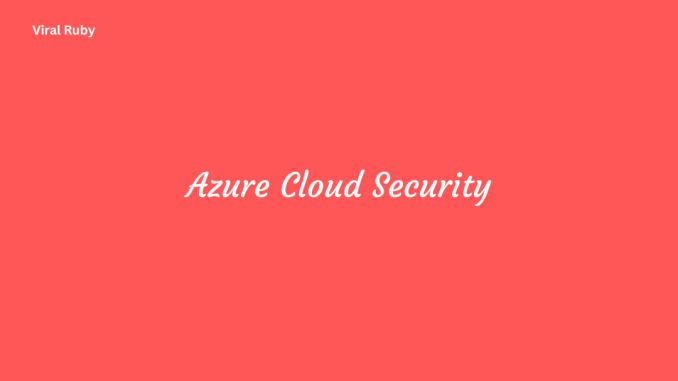
Azure Cloud Security Features and Services
Introduction to Azure Cloud Security: Ensuring Protection and Compliance
In today’s digital landscape, cloud computing has become an integral part of businesses worldwide. Among the leading cloud service providers, Microsoft Azure offers a comprehensive set of services for building, deploying, and managing applications and infrastructure. However, as organizations move their data and workloads to the cloud, ensuring robust security measures becomes crucial. This introduction aims to provide an overview of Azure Cloud Security, focusing on the importance of protection and compliance within the Azure environment.
Understanding Azure Cloud Security:
Azure Cloud Security encompasses a range of practices, technologies, and policies designed to safeguard data, applications, and infrastructure hosted on the Azure platform. It offers a layered security model that protects against potential threats and ensures the confidentiality, integrity, and availability of resources.
Key Security Features in Azure:
a. Identity and Access Management (IAM): Azure provides robust IAM capabilities, allowing organizations to manage user identities, control access to resources, and enforce strong authentication methods, such as multi-factor authentication (MFA) and Azure Active Directory (Azure AD).
b. Data Encryption: Azure offers encryption mechanisms to protect data both at rest and in transit. Features like Azure Disk Encryption, Azure Storage Service Encryption, and Azure SQL Database Transparent Data Encryption ensure data confidentiality.
c. Network Security: Azure provides various network security features, such as virtual network isolation, network access control lists (ACLs), virtual private networks (VPNs), and Azure Firewall, enabling organizations to secure their network traffic and protect against unauthorized access.
d. Threat Detection and Monitoring: Azure Security Center offers advanced threat detection and monitoring capabilities, leveraging machine learning algorithms to identify potential security threats and vulnerabilities. Additionally, Azure Monitor provides insights into the performance and health of Azure resources.
Compliance and Regulatory Considerations:
Azure is designed to meet various compliance and regulatory standards across industries. It offers a wide range of compliance certifications, including ISO 27001, GDPR, HIPAA, and SOC, ensuring that organizations can meet their industry-specific requirements when it comes to data protection and privacy.
Best Practices for Azure Cloud Security:
a. Secure Access Management: Implement strong authentication methods, enforce access controls, and regularly review and manage user permissions to mitigate the risk of unauthorized access.
b. Data Protection and Encryption: Utilize encryption mechanisms, both at rest and in transit, to safeguard sensitive data from unauthorized disclosure or modification.
c. Continuous Monitoring and Threat Detection: Regularly monitor Azure resources, leverage Azure Security Center and Azure Monitor for threat detection and response, and implement proactive measures to address vulnerabilities.
d. Regular Backup and Disaster Recovery: Implement data backup and disaster recovery strategies to ensure business continuity in case of data loss or system failures.
e. Compliance and Auditing: Regularly assess and maintain compliance with relevant regulations and industry standards, ensuring proper documentation and auditing practices.
Key Security Features and Services Offered by Azure Cloud
Azure Cloud offers a wide range of key security features and services to help protect data, applications, and infrastructure. Some of the notable security features and services offered by Azure Cloud include:
Azure Active Directory (Azure AD): Azure AD provides secure authentication and access management for Azure resources. It supports multi-factor authentication (MFA), conditional access policies, single sign-on (SSO), and identity protection, ensuring only authorized users can access resources.
Azure Firewall: Azure Firewall is a cloud-based network security service that provides high-level protection for Azure Virtual Network resources. It acts as a barrier between the internet and the Azure resources, allowing organizations to define and enforce network access policies.
Azure DDoS Protection: Azure DDoS Protection safeguards applications and services from distributed denial of service (DDoS) attacks. It automatically detects and mitigates volumetric, state-exhaustion, and application layer attacks, ensuring availability and performance of resources.
Azure Security Center: Azure Security Center offers centralized security management and threat protection for Azure resources. It provides security recommendations, threat detection, and advanced analytics to help identify and remediate potential security vulnerabilities.
Azure Key Vault: Azure Key Vault allows you to safeguard cryptographic keys, secrets, and certificates used by cloud applications and services. It provides secure storage and management of keys, ensuring the protection of sensitive information.
Azure Information Protection: Azure Information Protection enables organizations to classify, label, and protect sensitive data. It offers data encryption, access controls, and rights management capabilities, ensuring data confidentiality and compliance with regulations.
Azure Security and Compliance Blueprints: Azure provides a set of predefined security and compliance blueprints that help organizations quickly deploy secure environments aligned with industry best practices and regulatory requirements.
Azure Sentinel: Azure Sentinel is a cloud-native security information and event management (SIEM) service that provides intelligent security analytics and threat intelligence. It uses advanced AI and machine learning to detect and respond to security threats across the organization.
Azure Virtual Network Service Endpoints: Azure Virtual Network Service Endpoints allow secure access to Azure services over a private network connection. It helps protect data from exposure to the public internet and reduces the attack surface area.
Azure Backup: Azure Backup provides reliable and scalable cloud backup solutions for data protection. It ensures that critical data is securely backed up and can be restored in case of accidental deletion, ransomware attacks, or other data loss scenarios.
Implementing Secure Azure Architectures and Infrastructure
As organizations increasingly rely on Microsoft Azure for their cloud computing needs, ensuring the security of Azure architectures and infrastructure becomes paramount. Implementing robust security measures within Azure is essential to protect sensitive data, mitigate risks, and maintain the integrity of systems and applications. This guide will outline key considerations and best practices for implementing secure Azure architectures and infrastructure.
Secure Design Principles:
a. Defense-in-Depth: Apply multiple layers of security controls throughout the Azure architecture, including network security, access controls, and data encryption. This approach helps mitigate the impact of potential vulnerabilities or breaches.
b. Least Privilege: Assign the minimum necessary permissions to users and resources, ensuring that access is granted only to authorized individuals or systems. Regularly review and update access controls to minimize the risk of unauthorized access.
c. Resource Segmentation: Employ virtual networks, subnets, and network security groups to logically segregate resources and control communication between them. This limits the lateral movement of threats and enhances overall security.
d. Resilience and Redundancy: Implement redundancy measures such as availability zones, regional pairs, and geo-replication to ensure high availability and disaster recovery capabilities in case of infrastructure failures or natural disasters.
Identity and Access Management (IAM):
a. Azure Active Directory (Azure AD): Utilize Azure AD for centralized user identity and access management. Enforce strong authentication methods, such as multi-factor authentication (MFA), and implement role-based access controls (RBAC) to grant privileges based on job responsibilities.
b. Privileged Identity Management (PIM): Employ PIM to manage and monitor privileged access to Azure resources. Require just-in-time access, time-bound access, and approval workflows for elevated permissions, reducing the risk of misuse.
c. Azure AD Conditional Access: Implement conditional access policies to enforce additional security measures, such as device compliance checks, location-based restrictions, and risk-based authentication, based on contextual factors.
Data Protection and Encryption:
a. Azure Disk Encryption: Enable Azure Disk Encryption to encrypt virtual machine disks, safeguarding data at rest. Utilize Azure Key Vault to securely store and manage encryption keys.
b. Transport Layer Security (TLS): Implement TLS to encrypt data in transit between Azure services, applications, and users, preventing unauthorized interception or tampering.
c. Azure Storage Service Encryption: Enable encryption for Azure Storage accounts, ensuring that data stored in Azure Blob Storage, Azure Files, and Azure Queue Storage is encrypted at rest.
Network Security:
a. Network Security Groups (NSGs): Use NSGs to enforce network access controls at the subnet or network interface level. Restrict inbound and outbound traffic based on specific rules and IP address ranges.
b. Azure Firewall: Deploy Azure Firewall to provide centralized network security policy enforcement, protecting Azure Virtual Networks from unauthorized access and application-level threats.
c. Azure DDoS Protection: Enable Azure DDoS Protection to defend against Distributed Denial of Service (DDoS) attacks, safeguarding Azure resources and ensuring continuous availability.
Monitoring, Logging, and Incident Response:
a. Azure Security Center: Utilize Azure Security Center to gain visibility into security posture, identify vulnerabilities, and enable threat detection and response. Leverage security recommendations to enhance security configurations.
b. Azure Monitor: Implement Azure Monitor to collect and analyze telemetry data from Azure resources. Set up alerts and notifications to detect and respond to security events and anomalies.
c. Incident Response Plan: Develop an incident response plan that outlines steps to be taken in the event of a security incident. Regularly test and update the plan to ensure an effective response and minimize downtime.
Azure Security Center: Monitoring and Threat Detection in the Cloud
Azure Security Center is a comprehensive security management and threat detection solution offered by Microsoft Azure. It provides organizations with the tools and capabilities to monitor and protect their cloud environments from various security threats. Here are the key features of Azure Security Center related to monitoring and threat detection:
Security Policy Assessment: Azure Security Center helps organizations assess their security posture by providing security recommendations based on industry best practices and Azure security controls. It evaluates the security configuration of resources and provides actionable insights to enhance security.
Continuous Monitoring: Azure Security Center continuously monitors Azure resources and workloads, collecting security-related data and logs. It offers visibility into resource health, security alerts, and compliance status, enabling organizations to detect potential security issues in real-time.
Threat Detection: Azure Security Center employs advanced analytics and machine learning algorithms to identify and detect security threats. It analyzes network traffic, system logs, and behavioral patterns to detect indicators of compromise and potential attacks.
Security Alerts and Incident Response: Azure Security Center generates security alerts based on detected threats and suspicious activities. It provides detailed information about each alert, including recommended actions for incident response and mitigation. Integration with Azure Sentinel allows for centralized incident management and response.
Just-in-Time (JIT) Access: Azure Security Center enables organizations to implement Just-in-Time (JIT) access control for virtual machines and network ports. It allows administrators to define specific time windows and IP addresses for accessing resources, reducing the attack surface and limiting exposure to potential threats.
Network Security Group (NSG) Recommendations: Azure Security Center provides recommendations for Network Security Groups (NSGs) to help organizations secure network traffic. It identifies insecure NSG rules and offers suggestions to enhance network security and restrict unauthorized access.
Security Center API: Azure Security Center offers an API that allows integration with other security tools and systems. Organizations can leverage this API to extract security-related data and integrate it with their existing security information and event management (SIEM) solutions.
Regulatory Compliance: Azure Security Center helps organizations comply with various regulatory requirements by providing built-in regulatory compliance assessments and reports. It supports compliance frameworks such as PCI DSS, ISO 27001, HIPAA, and GDPR.
Security Baselines: Azure Security Center provides predefined security baselines that organizations can use to align their security configurations with recommended practices. These baselines help organizations establish a secure foundation for their Azure resources.

Leave a Reply